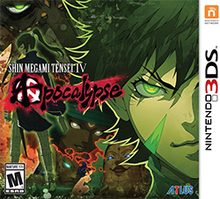
Many videogame corporations have a habit of really stagnating when it comes to numbered entries of their flagship series, akin to a certain Capcom fighting franchise whose name rhymes with “meat biter” and one from Disney and Square-Enix whose name rhymes with “bring them arts.” However, there is the rare occasion where said games between “official” sequels are actual original games, similar to Final Fantasy X-2, which had vastly-different mechanics from the mainline tenth Final Fantasy. Another instance of this is Atlus’s direct sequel to the fourth mainline Shin Megami Tensei series on the Nintendo 3DS, Shin Megami Tensei IV: Apocalypse.
Apocalypse follows on its predecessor’s neutral route, with silent protagonist Nanashi dies while on a demon hunt, contacted in the afterlife by the entity Dagda, who offers to revive the hero in exchange for becoming his Godslayer. The story is largely enjoyable, although there is perhaps a narrative nod or two to the Star Wars franchise, but the plot direction is far better than in the previous game, with plenty of choices that alter the ending the player ultimately receives. The translation luckily doesn’t detract from the plot, with Atlus not having censored it, although there are some odd stylistic decisions, for instance, regarding things such as when enemy demons request certain types of items.
The sequel largely improves upon its precursor’s mechanics, with visible encounters on the overworld and most places in between that Nanashi can slash with his current weapon so he can get the advantage in battle, in many cases dealing some initial damage to whichever demons he faces. The core gameplay is largely the same, with some exceptions such as no longer needing a special app (which return from the first game) to communicate with certain demons, and the addition of partners that level alongside the hero and his demons, the player able to set one at a time and who uses one of his or her abilities after the player’s turn session.
Other changes include the decreased flakiness of demons during negotiation, where whenever they offer a “final price” for recruitment, they don’t flake out. Fusion is the same, and the player can still register demons in the Demon Compendium for resummoning at a price. One exploit I discovered that solved my financial problems was to keep demons and Nanashi with an ability to stun foes, where, when using the Fundraise ability, I could farm endless money from them. The other means of acquiring money, involving the salvage of relics from special points, returns as well, and aside from the lack of direct control over partners, I had a blast with the battle system.
Control is perhaps the most-improved aspect of Apocalypse over its predecessor, with areas on the bottom screen’s map for the overworld, for example, actually having labels for specific locations, in addition to clear direction as how to advance the central storyline, to the point where I finished the game without referencing the internet at all. The save-anywhere feature from the first game returns, along with the general ease of navigating the primary interface, in-game record of playtime, and easy shopping. The myriad of options in the fusion matrix comes back as well, and aside from some things not always receiving indication on the in-game maps, the game is very user-friendly.
The direct sequel also features new music from its precursor, with pretty much every track being solid, although there are occasional areas that rely upon ambience. The voicework is also solid in spite of a few weak performances.
The visuals largely remain unchanged, with fully three-dimensional travel throughout the various districts, dungeons, and whatnot, perks such as different equipment affecting the protagonist’s appearance carrying over, although combat remains in first-person, but the enemy designs are still solid and devoid of reskins.
Finally, the sequel is about as long as its precursor, taking somewhere from forty-eight to seventy-two hours to complete, with several different New Game Plus options and the choices throughout the game enhancing lasting appeal, although it may be too long for some to go through again.
Ultimately, Shin Megami Tensei IV: Apocalypse is very much what a direct sequel should be, given its solid and in some cases refined game mechanics, vastly-improved control over the first game, an enjoyable narrative with potential variations for different playthroughs, and great audiovisual presentation. There are a few minor issues, however, mostly involving the localization, the recycled graphics from its precursor, and that it may be a little long for some. Regardless, it’s very much a must-play Nintendo 3DS game, but lamentably, as with most Atlus games, used copies go for a lot of money, and the Big N’s eShop is fated to close in March 2023, so interested parties would definitely do themselves well to purchase and download it before then.
This review is based on a single playthrough of a digital copy downloaded to the reviewer’s Nintendo 3DS on Skirmish difficulty.
The Good:
+Well-refined game mechanics.
+Improved control over first game.
+Great story with different choices.
+Excellent soundtrack and voicework.
+Good visual direction.
The Bad:
-Some minor localization issues.
-Graphics largely unchanged from previous game.
-A little long.
The Bottom Line:
A great sequel improving on its predecessor in most aspects.
Score Breakdown:
Platform: Nintendo 3DS
Game Mechanics: 9.5/10
Controls: 9.5/10
Story: 9.5/10
Localization: 8.5/10
Music/Sound: 9.5/10
Graphics: 9.0/10
Lasting Appeal: 9.5/10
Difficulty: Adjustable
Playing Time: 48-72 Hours
Overall: 9.5/10
No comments:
Post a Comment